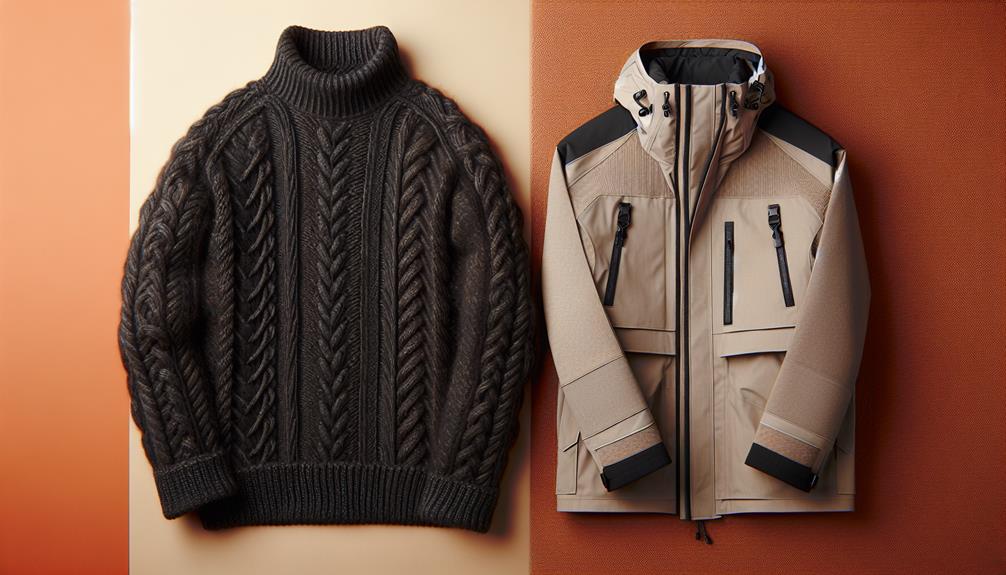When it comes to distinguishing between a sweater and a jacket, it's like comparing apples and oranges – they serve different purposes in one's wardrobe.
But have you ever wondered what truly sets them apart beyond just their appearances?
Let's unravel the intriguing complexities that lie beneath the surface of these two common yet distinct pieces of clothing.
Table of Contents
Key Takeaways
- Sweaters prioritize warmth and comfort, while jackets focus on style and protection.
- Materials and construction determine the distinction between sweaters and jackets.
- Jackets feature zippers or buttons, while sweaters commonly pullover for closure.
- Sweaters are cozy and casual, while jackets are versatile and polished in design.
Definitions of Sweater and Jacket
What exactly distinguishes a sweater from a jacket in terms of their definitions?
A sweater is a knitted garment that's worn on the upper body to provide warmth and comfort. Typically made from materials like wool, cotton, or synthetic fibers, sweaters come in various styles such as pullovers, cardigans, V-necks, turtlenecks, and crew necks.
On the other hand, a jacket is an outerwear garment made of rigid fabrics like woven or leather, featuring zippers or buttons for closure. Jackets are usually shorter and more structured than sweaters, offering protection from the elements and a more polished appearance.
While sweaters tend to be more casual and cozy, jackets are versatile outer layers that can be dressed up or down for different occasions and levels of formality.
The distinction lies in the materials, construction, and intended use of each garment, with sweaters focusing on comfort and warmth for the upper body, while jackets prioritize style and protection.
Fabric and Construction Variances
Moving from the definitions of sweaters and jackets, the fabric and construction variances play a crucial role in distinguishing between these two garments.
Sweaters are typically made from materials like wool, cashmere, or synthetic fibers, giving them a soft and cozy feel. They're usually knitted or crocheted, creating different textures and patterns that add to their appeal.
On the other hand, jackets are typically constructed from more rigid fabrics such as cotton, leather, or polyester, providing structure and durability. Jackets often feature front closures like zippers or buttons, offering a more secure fit compared to pullover sweaters that are slipped on over the head without closures.
While sweaters are designed for warmth and comfort, jackets serve as outerwear for protection and style, with features like collars, lapels, and pockets.
These fabric and construction variations between sweaters and jackets contribute significantly to their distinct styles, functions, and overall aesthetics.
Style and Design Differences
When it comes to style and design differences between sweaters and jackets, the materials used play a significant role in determining the overall look.
The length of the garment also varies, with jackets typically being shorter than most sweaters.
In terms of closure options, jackets often feature zippers or buttons, while sweaters commonly have a pullover design.
Material Differences
Sweaters and jackets exhibit distinctive material differences that not only influence their style but also impact their overall design aesthetics.
Sweaters are typically knitted from soft materials like wool or synthetic fibers, providing warmth and comfort. In contrast, jackets are constructed from rigid fabrics such as cotton, leather, or polyester, offering durability and structure.
The choice of material also influences the design details; jackets often feature collars, lapels, and functional pockets, emphasizing practicality, while sweaters come in various designs like V-neck, turtleneck, or crew neck, focusing on style and coziness.
Understanding these material disparities is crucial for selecting the right garment based on the desired functionality and fashion statement.
Length Variation
Exploring the style and design differences between jackets and sweaters, one notable distinction lies in their varying lengths, which significantly influences their overall aesthetic and functionality.
Length Variation:
- Jackets are typically shorter, providing upper body protection while ending at the waist or hips.
- Sweaters offer a range of lengths, from cropped to hip-length or longer, ensuring diverse styling options.
- The length of a garment impacts its overall look and functionality, with jackets favored for layering versatility.
Understanding the length variation between these two garments is crucial for achieving balanced outfits tailored to different occasions. The choice between a shorter jacket for a structured look or a longer sweater for added warmth can make a significant impact on your overall style.
Closure Options
Front closures play a crucial role in distinguishing the style and design differences between jackets and sweaters. Jackets commonly feature front closures such as zippers, buttons, or snaps, enabling easy wear and removal. These closures not only provide functionality but also contribute to the garment's aesthetic appeal.
In contrast, sweaters often lack front closures, requiring them to be pulled over the head due to the stretchiness of the knit fabric. Understanding these closure options highlights the practical and stylistic variances between jackets and sweaters.
While jackets emphasize convenience with prominent closures, sweaters prioritize simplicity and comfort through their pull-on design. The choice of closure can significantly impact the overall look and feel of the garment, reflecting the intended purpose and design aesthetic.
Layering Capabilities
When it comes to layering capabilities, sweaters offer insulating warmth for those chilly days, while jackets provide protection from the elements like wind and rain.
The combination of a sweater under a jacket allows for versatile styling options that can adapt to different temperatures throughout the day.
Insulating Warmth
Sweaters outperform jackets in providing insulating warmth, making them ideal midlayers for trapping body heat during colder temperatures. When considering layering capabilities for warmth, sweaters have a distinct advantage over jackets. Here's why:
- Heat Retention: Sweaters, with their knit or crochet construction, excel at trapping heat close to the body, offering superior warmth compared to jackets.
- Bulk vs. Insulation: Jackets may provide outerwear protection, but sweaters offer more insulation without the added bulk, making them perfect for layering under jackets for enhanced warmth.
- Versatility: Sweaters can be layered under coats or over shirts, offering different levels of warmth based on materials and thickness, providing adaptable insulation options for varying weather conditions.
Versatile Styling
With their versatile layering capabilities, both sweaters and jackets offer a range of stylish options to enhance any outfit. When considering the layering options of sweaters vs. jackets, it's essential to understand how each piece can contribute to a stylish outfit. Sweaters excel at being worn over shirts or under jackets, providing both warmth and a touch of sophistication. On the other hand, jackets offer additional layering possibilities, protecting against the elements while adding a trendy flair. By layering a sweater under a jacket, you can create a versatile and stylish look suitable for various weather conditions. Mixing textures and colors between sweaters and jackets allows for endless outfit combinations, ensuring a personalized and fashion-forward appearance.
| Sweaters | Jackets | Stylish Outfit |
|---|---|---|
| Layer over shirts | Additional layering | Mix textures and colors |
| Layer under jackets | Protection | Create a personalized look |
| Provide warmth | Trendy flair | Versatile styling |
Seasonal Suitability
Ideal for different seasons, jackets offer versatility in style and functionality. When considering seasonal suitability, here are some key points to keep in mind:
- Sweaters for Fall and Winter: Sweaters excel in cooler seasons like fall and winter due to their warmth and insulating properties. Materials like wool and cashmere provide excellent insulation, making them perfect for layering during the colder months.
- Lightweight Jackets for Spring and Summer: Jackets come in various weights, with lightweight options like windbreakers or denim jackets ideal for spring and summer. These lighter jackets are perfect for transitional seasons when temperatures fluctuate, offering both style and comfort.
- Layering for Added Versatility: Pairing a sweater under a jacket can enhance warmth and style during colder seasons. This combination allows for a mix of textures and patterns, creating a sophisticated and layered look that's both practical and fashionable.
Occasions for Wearing Each
For various occasions, jackets and sweaters offer distinct styles and levels of formality. Sweaters are perfect for casual outings or lounging at home, providing a relaxed and cozy look. They're ideal for layering in cooler weather or for a laid-back vibe during leisure activities. On the other hand, jackets are more suited for formal occasions such as business meetings, dinners, or events where a polished and structured appearance is desired. Jackets offer a touch of sophistication and are great for creating a professional look or for attending special gatherings where a more refined outfit is appropriate.
Understanding the occasions best suited for sweaters versus jackets is essential for creating the right outfit for different events. Whether you opt for a sweater for a casual look or a jacket for a formal touch, both garments worn on the upper body play a significant role in defining your style and setting the tone for the occasion.
Versatility in Outfit Pairing
When deciding between a sweater and a jacket, it's important to consider the versatility in outfit pairing.
Color coordination options, layering possibilities, and style statement differences play a significant role in how these pieces can transform an ensemble.
Whether it's mixing and matching colors or playing with textures, both sweaters and jackets offer unique ways to elevate your look effortlessly.
Color Coordination Options
With a myriad of color options available for both sweaters and jackets, creating versatile outfit pairings becomes an exciting opportunity to showcase individual style. When coordinating colors between sweaters and jackets, there are endless possibilities to mix and match for a dynamic look.
Here are some tips to help you master color coordination:
- Neutral Palette: Opt for classic neutral tones like black, gray, and navy in sweaters for a versatile base that pairs well with a range of jacket colors.
- Bold Statement: Experiment with bold jacket colors such as red, blue, or green to add a pop of vibrancy to your outfit while keeping the sweater more neutral.
- Complementary Combos: Mix and match colors between your sweater and jacket to create stylish and cohesive ensembles that showcase your personality.
Layering Possibilities
Exploring the layering possibilities between sweaters and jackets reveals endless outfit combinations for versatile and stylish looks. Sweaters offer a cozy option when layered over shirts, perfect for a casual and relaxed vibe.
On the other hand, jackets provide versatility by allowing layering over different tops like t-shirts, button-down shirts, or even sweaters, creating diverse outfit options. Pairing sweaters with skirts, jeans, or trousers can result in a chic and comfortable ensemble, while jackets can be styled with dresses, pants, or shorts for various occasions.
Combining a sweater under a jacket not only adds texture and warmth but also showcases a stylish and practical approach, especially in cooler weather. Mix and match different colors, patterns, and textures to elevate your outfit and express personal style creatively.
Style Statement Differences
Sweaters and jackets each make a distinct style statement through their versatility in outfit pairing, allowing for a range of looks from casual to sophisticated. When considering the differences in style statements between sweaters and jackets:
- Casual to Formal: Sweaters excel in offering a casual and cozy vibe, ideal for everyday wear. On the other hand, jackets effortlessly transition an outfit from casual to formal, adding a touch of refinement.
- Made from Wool: Sweaters, often crafted from wool, provide warmth and comfort, making them perfect for colder seasons. Jackets, also commonly made from wool blends, offer structure and durability for a more polished appearance.
- Accessories and Styling: Sweaters allow for creative accessorizing with scarves or jewelry, adding personal flair to an ensemble. Jackets, with their tailored designs, offer a sleek canvas for minimalistic or bold accessories to shine.
Storage and Maintenance Needs
When storing and maintaining clothing items like jackets and sweaters, it's essential to consider their specific needs to ensure longevity and quality preservation.
Sweaters, typically folded and stored on shelves, maintain their shape and prevent stretching. Occasionally reshaping sweaters by laying them flat to dry after washing helps retain their original silhouette. Delicate materials like cashmere may benefit from breathable garment bags to protect them from moths and dust.
On the other hand, jackets, especially leather ones, should be hung on sturdy hangers to prevent creasing and maintain their structure. Jackets often require spot cleaning or professional leather cleaning to preserve their quality and appearance.
Understanding these storage and maintenance needs for sweaters and jackets is crucial in extending the lifespan of these garments and keeping them in top condition for years to come.
Price Points and Value
Typically priced lower than jackets, sweaters offer a budget-friendly option for adding style and warmth to outfits. When considering the price points and value of sweaters and jackets, it's important to understand the differences between the two:
- Material and Insulation: Sweaters are usually made from lighter materials like cotton or wool, making them more affordable compared to jackets that may use high-quality materials such as leather. Sweaters provide a moderate level of insulation suitable for layering in milder weather.
- Functionality and Features: Jackets tend to be pricier due to their functionality and additional features. Waterproofing, multiple pockets, adjustable hoods, and specialized linings are common in jackets, increasing their value for protection against the elements.
- Comfort and Versatility: The value of a sweater lies in its comfort and versatility for everyday wear. While jackets are often seen as investment pieces for specific needs, sweaters offer a more budget-friendly option for those looking to stay stylish and warm without breaking the bank.
Historical Evolution of Sweaters and Jackets
How did the historical evolution of jackets and sweaters shape the modern fashion landscape?
Sweaters, with their origins dating back to the 15th century in Europe, were initially knitted garments crafted for practical warmth, commonly worn by fishermen and sailors. Jackets emerged in the 19th century as tailored outerwear designed for military and civilian use, serving purposes like protection from the elements or ceremonial functions.
The industrial revolution played a pivotal role in the mass production of both sweaters and jackets, making them more accessible to a broader audience. Over time, these garments have evolved in style and functionality, mirroring shifts in fashion trends, technological advancements, and cultural influences.
Today, we see sweaters available in various knitted styles, offering both warmth and style, while jackets come in different types catering to specific needs, such as bomber jackets for casual wear or blazers for formal occasions. The historical journey of sweaters and jackets has significantly influenced the diverse offerings we see in contemporary fashion.
Sustainability and Eco-Friendliness
Choosing eco-friendly materials for sweaters and jackets is a pivotal step towards promoting sustainability in the fashion industry. When considering sustainability and eco-friendliness in clothing, opting for organic cotton or recycled materials can make a significant impact. Here are three key points to consider:
- Sweaters made from organic cotton or recycled materials play a crucial role in reducing environmental impact and promoting sustainable practices in fashion.
- Eco-friendly jackets often utilize materials like recycled polyester or sustainable wool, which help in minimizing the carbon footprint and promoting responsible sourcing.
- Sustainable production processes for sweaters and jackets focus on reducing water usage, energy consumption, and overall carbon emissions during manufacturing, contributing to a more eco-conscious approach in the fashion industry.
Frequently Asked Questions
What Is Considered a Sweater?
When I think of what is considered a sweater, it's like wrapping oneself in a cozy hug. The warmth, style, and versatility of sweaters make them a wardrobe essential. From cable-knit to cashmere, sweaters offer both comfort and fashion.
What Is the Difference Between Sweatshirt and Jacket?
When comparing a sweatshirt to a jacket, the key differences lie in their design and purpose. While sweatshirts offer comfort and casual style, jackets provide protection and versatility for various occasions. Both serve unique functions.
What Is the Difference Between a Hoodie and a Sweater?
As for the difference between a hoodie and a sweater, a hoodie boasts a cozy hood for style and warmth, while a sweater is a classic knit for comfort. Each piece brings its unique charm to my wardrobe.
What Is Considered a Jacket?
I consider a jacket as an outer garment worn on the upper body, typically fastened with buttons or zippers, offering versatility and style. Jackets vary in styles like bomber, denim, leather, and parka, suitable for transitional weather.
- Does Dri Fit Keep You Cool - March 5, 2024
- Can You Silkscreen on Polyester - March 5, 2024
- How Many Teeth in a Zipper - March 5, 2024







